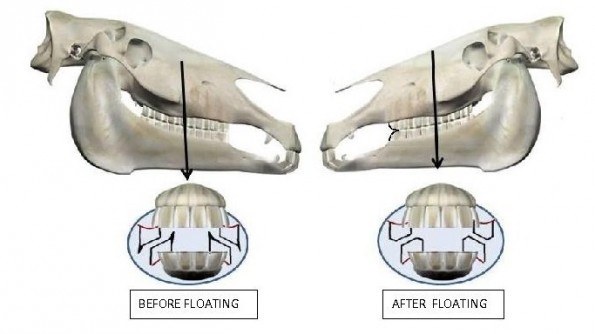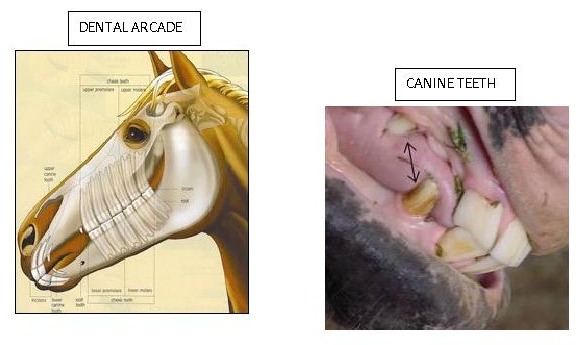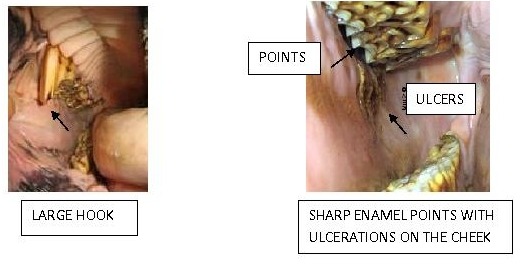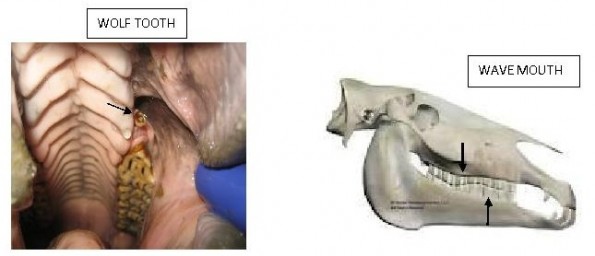The importance of equine dental care has increased over the past several years, and as a result, our patients are living longer. Proper dental care has many important benefits including a more comfortable mouth, better feed efficiency, increased or improved performance, and increased longevity.
Equine teeth continually erupt throughout their life and are continually worn down by grinding and chewing their food. Horses chew in a side to side circular manner. They slide their mandible (lower jaw) caudally (back) when their head is raised and the mandible moves rostral (forward) when the head is lowered.
During this process, sharp enamel points are formed on the cheek teeth. Points are formed on the outside (buccal or cheek side) of the upper cheek teeth and on the inside (lingual or tongue side) of the lower cheek teeth.

The adult horse can have up to 44 total teeth; 12 of which are incisors (front teeth), 12 are premolars (first 3 cheek teeth), 12 are molars (last 3 cheek teeth), 4 are canines, and up to 4 wolf teeth (2 on the top and 2 potential ones on the bottom). Juvenile horses have a total of 24 deciduous or baby teeth, which begin to be replaced by permanent teeth at 2 ½ years of age. Horses should have a full set of adult teeth by 5 years of age.

Abnormalities within the dental arcade will affect the wear patterns on the cheek teeth and likely require more frequent examinations and treatments. It is recommended to begin dental examinations starting at a young age (weanlings) and continuing on a 6 month to 1 year examination schedule. The frequency of dental floating or equilibration is dependent on each individual horse. Some horses require treatments as often as every 6 months and some horses can go 2 to 3 years before requiring treatment.
The most common dental abnormalities include
- Sharp enamel points (on the outside or cheek side on the upper arcade and on the inside or tongue side on the lower arcade)
- Retained deciduous (baby) teeth, also known as “caps”.
- Wolf teeth (usually on the top)
- Wave mouth and Step mouth (both resulting in abnormal or uneven bite planes resulting in decreased feed efficiency)
- Hooks
- Lost, removed, or fractured/broken teeth
- Excessive tooth wear (usually in the geriatric patients)
- Misalignments (i.e. over bite or parrot mouth and under bite or monkey mouth)
- Periodontal (gum) disease


The most common clinical signs associated with dental abnormalities
- None
- Dropping feed (especially grain or pellets), quidding hay (balling up hay and spitting out), drooling, abnormal chewing
- Weight loss or loss of body condition
- Large or undigested feed in the manure (long hay stems and/or grain)
- Accumulation of feed in the cheeks (swelling along the cheeks)
- Head tilting, head tossing, fighting the bit, poor performance
- Odor from the mouth and/or nose
- Blood from the mouth
- Nasal discharge, facial swelling(s)
Oral and dental examinations should be performed at least annually. Young horses should be examined at least by 1 year of age if not sooner to check for any abnormalities in alignment and eruption.
Horses aged 2-5 often require yearly dental work because they are losing deciduous teeth and erupting permanent teeth from 2 ½ to 4 ½ years of age. Deciduous (baby) teeth are softer than permanent teeth and often form sharp enamel points quickly.
Prior to going into a training regimen horses should be examined for sharp enamel points and wolf teeth, both of which can adversely affect the bit and training. Geriatric horses are more predisposed to periodontal disease, loose teeth, and excessive wear; these individuals should be examined bi-annually.
Dental abnormalities can be addressed with routine occlusal equilibration (floating) using both power floats and hand floats. Horses with loose or diseased teeth often require extraction (removal).
Horses with excessive abnormalities should be addressed biannually to yearly starting at a young age. When presented with an older horse with significant abnormalities, it is often very difficult or impossible to properly correct and often requires frequent treatments.
To keep your horse maintained and healthy, consult with your veterinarian for questions concerning your horse’s mouth, abnormalities, and dental equilibration (floating).
Tanya Balaam-Morgan, DVM, Diplomate ABVP (equine practice)
Large Animal Veterinary Services
Chilcoot, California




